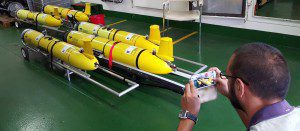
Using hydrophone- and hydrophone-array-equipped gliders, which have no propulsion and operate silently, scientists shall be able to obtain seabed types and layer structures by listening to and then analysing ambient noise in the ocean.
From Aug. 26-Sept. 9, 2015, the NATO Research Vessel Alliance will conduct the oceanographic campaign GLISTEN '15 in the Tyrrhenian Sea north of Elba Island, Italy. Scientists from the NATO STO Centre for Maritime Research and Experimentation (CMRE) and their partners from nine institutions of five NATO nations (Canada, Italy, Norway, United States and United Kingdom) will collect acoustic, oceanographic and geophysical data using traditional and novel observation methods, such as underwater gliders.
In particular, GLISTEN '15 aims to test the readiness and feasibility of novel payloads and smart-sensing methodologies that CMRE developed to enhance current capabilities for ocean-environment characterisation.
A deeper knowledge of this area could be also beneficial to the local communities for more-effective protection of the marine environment, said Yong-Min Jiang, CMRE GLISTEN '15 Scientist in Charge. The final data will be made available to the scientific community under request.

